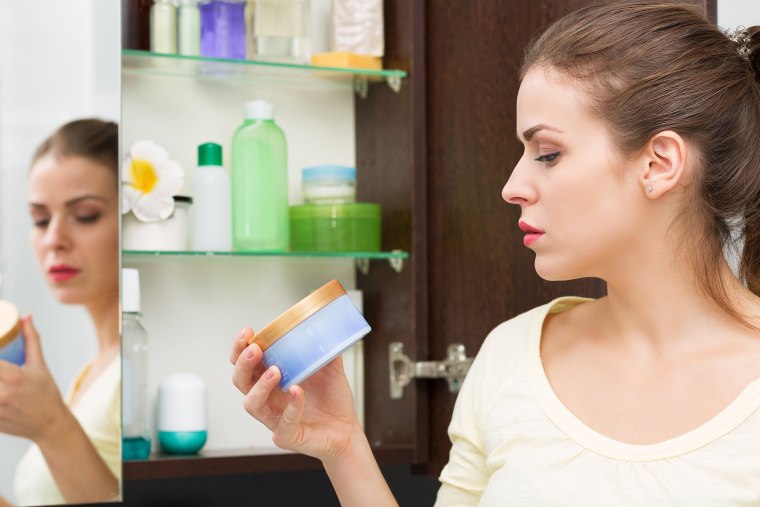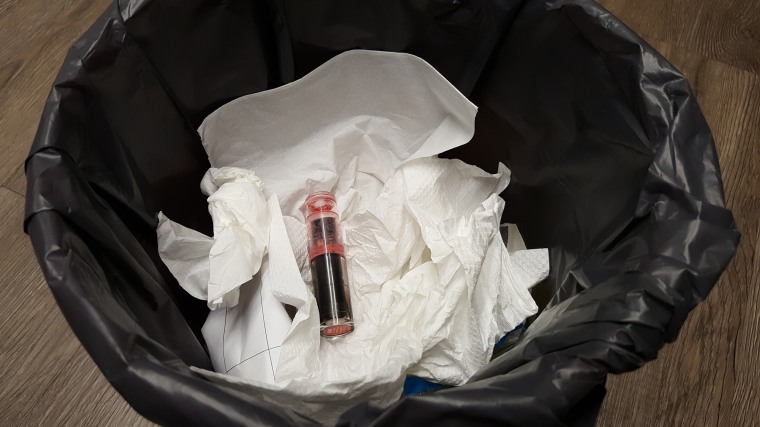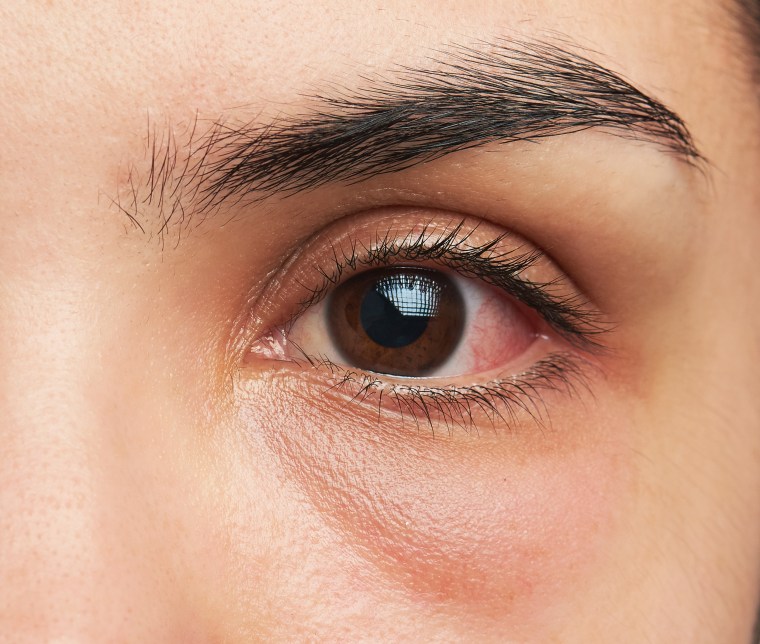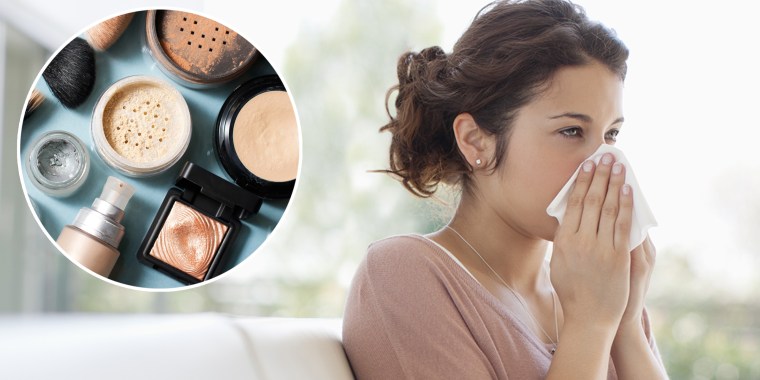Parting with your favorite lotion or mascara is hard enough when it’s past its prime (yes, beauty products expire), but the thought of throwing out makeup after any and every cold or infection just doesn’t seem fair.
So, do you really have to purge your beauty cabinet every time you get sick, or is there a simple way to disinfect your beauty products? TODAY Style asked the experts to weigh in.

Do beauty products harbor germs?
Beauty products are made with preservatives that keep them fresh for a certain period of time. Can those preservatives protect them from spoiling after you’re sick? Can beauty products harbor germs and, if so, for how long? Like many matters of beauty, the answers are a bit complicated.
“Color cosmetics that involve you applying the product directly to your skin from the package can harbor germs. How long depends on the microbe, but you should assume that they can last as long as you own the product,” Perry Romanowski, a cosmetic chemist who co-founded the website The Beauty Brains, said.
Long story short? Every time you apply a product — like lipstick, mascara, eye shadow, etc. — directly to your skin, you expose the products to your skin’s microbes. That means that any germs you’re harboring, including the nasty flu virus, can end up in your products.
"Depending on the bacteria or virus and depending on the type of product and its ingredients, beauty products can remain contaminated from a range of a few hours or days to much longer," said Dr. David Lortscher, a board-certified dermatologist and the CEO and founder of Curology.
Although some preservatives get a bad name, they're helpful in this case, working overtime to make sure your favorite lipstick doesn't get you sick.
“If your product isn't properly preserved, the microbes can continue to persist," Romanowski said. But he added, "Even with proper preservation, the microbes can exist in a spore form ready to regrow when conditions are right,”
Not every beauty product is a breeding ground for germs, though. Those that you dispense into your hand —think shampoos, conditioners, body wash and some skin lotions — aren’t directly exposed to microbes, so they’re safe to continue using.

When should you throw out makeup?
It’s just not practical to toss your favorite beauty products every time you have a little sniffle. But are there certain instances when you should cut your losses and just throw out your makeup?
“If you just had a common cold, I wouldn’t toss all your makeup, but I would consider replacing or setting aside any lip products that you used throughout the illness.”
Dr. David Lortscher
“For the most part, you don't have to toss your beauty products after being sick. I would recommend getting rid of any natural products because they are likely not preserved well enough, but for most products, the germs that do get back into your products will not represent a problem (unless someone has a compromised immune system),” Romanowski said.
That’s because your immune system develops antibodies to fight infection and recognize a particular pathogen in the future. “So even though there may be some residual spores in your products, your body can already stop any future infection from these specific microbes. Reinfection is unlikely," Romanowski said.
At the same time, it’s always good to toss your lip products, especially those with a wand applicator, after you’re sick or experience a cold sore since they come in direct contact with saliva. “If you just had a common cold, I wouldn’t toss all your makeup, but I would consider replacing or setting aside any lip products that you used throughout the illness,” Lortscher said.

What about pink eye, styes and skin infections?
Pink eye and styes are the gifts that keep on giving ... in the worst possible way. That’s because after you’re in the clear and have gotten rid of your eye infection, you still have to worry about reinfecting yourself by using contaminated beauty products.
“Pink eye is a sneaky virus that can live on objects. I recommend throwing away any eye makeup you used while infected, especially anything with a wand applicator that you dip into the tube or bottle (think mascara, liquid eyeliner, etc.),” said Dr. Melissa Peck Piliang, MD, FAAD, associate program director of Dermatology Residency at the Cleveland Clinic. “When you put the wand back in the tube, you contaminate all of the product.”
Eye infections are typically highly contagious and can easily come back if you reuse contaminated products, so do yourself a favor and just toss your eye products, including those roll-on eye gels!
Skin infections can also wreak havoc on your favorite beauty products, so you should always make sure to clean your makeup brushes frequently to nix any lingering bacteria. "Makeup brushes should be washed with antibacterial soap once a week and allowed to dry thoroughly. Do an extra washing after you have been ill," Piliang said.
You’d think that facial cleansing sticks might need to be tossed after an infection, but you can actually use the same quick-and-easy alcohol cleanser method. Sponge applicators, on the other hand, are better off in the trash after an infection.
Can you clean your beauty products?
Is there any good way to disinfect your beauty cabinet? Turns out, it depends on the product type.
"Unfortunately, if your makeup has a wand applicator (mascara, lip gloss) there is no way to fully disinfect the product because the wand has been exposed to the bacteria and has most likely infected the rest of the tube," Lortscher said.
At the same time, certain beauty products can be more easily cleaned. Powder eye shadow, eye pencils and lipstick tips, for instance, can be sprayed with alcohol. You can also shave the tip off your eye pencils or traditional lipsticks.
"Wipe each product with rubbing alcohol after each use to prevent product contamination and germ spreading," said Regine Berthelot, director of spa education at Caudalie.
Do yourself a favor and just toss your eye products, including those roll-on eye gels!
You can also easily prevent contamination just by applying your products using this sanitary method. "Always use a spatula for products in jars and avoid double dipping. It’s best to wash the spatula after each use," she suggested. "When squeezing a product from a tube, do not place your finger on the tube opening, rather squeeze on a clean surface so you are not pushing germs into the tube."
Makeup tools and skin care devices — like those popular facial cleansing brushes — should also be treated with care. "If you use a Clarisonic brush, it should be cleaned with soap, hot water and alcohol after each use. The brush should be changed at least every three months," Berthelot said. "If there is an acne flare up or skin infection, try to avoid the area to prevent spreading the infection."
How else can you keep your beauty products safe?
For starters, sharing makeup isn't a great idea.
“You can get sick from someone else's makeup and they can get sick from using yours. This is also why it's advisable to avoid product testers at stores unless there is a disposable applicator,” said Romanowski.
Shared lip and eye products, in particular, are most likely to get you sick. “Lipstick and eyeliner are applied in areas on or next to mucosa (this is the tissue inside your mouth or on the inside of your eyelid). This skin is a direct port of entry for many bacteria and viruses," Piliang said.
Storing your makeup in the right conditions can also help prevent nasty microbes from growing. “Temperatures over 85 degrees F (like in a hot car) can break down the preservatives and help bacteria to grow. Storing cosmetics in a cool, dry place is the most safe behavior,” Romanowski said.
